Knowing the basics of how the brakes work is just one of those things any ATV owner should learn. This knowledge makes troubleshooting a lot easier when they do not work properly. You are also better able to maintain and keep the brakes sharp at all times.
Be aware that there has been quite a lot of variations of ATV brake systems throughout the years. The types described in this post will cover most types, but not all of them.
So how do ATV brakes work? ATVs use either disc brakes, drum brakes, or a combination of these two systems.
When the rider of an ATV with disc brakes activates the hand lever or foot pedal, brake fluid is being squeezed through the brake lines, activating the brake piston. This, in turn, pushes the brake pad against the brake disk or brake drum, creating friction.
On bikes with drum brakes, pulling the brake lever activates a steel cable that forces the brake shoes outwards against the inside of the brake drum.
The brake system consists of these basic components that all work together:
The rider pulls or squeezes the lever against the handlebar to operate the brakes. Pulling the lever will generally activate the brakes on all four wheels of the bike.
Next to the hand lever on the handlebar, you find the master cylinder. This consists of a small reservoir containing brake fluid and a small piston that works as a hydraulic actuator.
When the hand lever is activated, the small piston pushes brake fluid down the brake line, making it a hydraulic system.
The reservoir should have a gauge to tell the current level of fluid inside. On bikes with the “eye” style indicator on top of the reservoir, a dark center usually means that the reservoir is full. A white center indicates low levels of fluid.
A black center indicates brake fluid levels are OK.
Consult your owner’s manual to learn how to check the level on your specific bike. Make sure it is above the minimum at all times, but do not overfill either. Doing so may cause brake drag or brake lock-up.
The brake line is a pipe or tube transferring brake fluid from the master cylinder to the caliper on each wheel. The line needs to withstand high pressures and consist of flexible lines or solid steel or copper pipes.
The hydraulic fluid is what makes the whole system work. It’s important to use the right type of fluid for your bike, usually DOT 3 or DOT 4. Notice that if just a tiny amount of air gets into the system, the brakes will not function properly.
On each wheel hub, you’ll find a brake caliper. The caliper is a metal housing containing one or more pistons. It also has the job of keeping the brake pads in place.
Each wheel has a brake disc that is directly connected to- and spins at the same speed as the wheel. When the brake fluid reaches the piston inside the caliper, the piston is being pushed against the brake pad, which in turn, is being pushed against the brake disc.
When the brake fluid reaches the piston inside the caliper, the piston is being pushed against the brake pad, which in turn, is being pushed against the brake disc.
The brake pad is made of a material that can handle the friction this creates, making the wheel spin slower.
Hand lever operated disc brakes activate the brake calipers either on all four wheels. Or they activate only on the two front wheels together with one of the rear wheels.
The latter option is true on bikes that rely on the rear diff to have brakes on both rear wheels. Thus needing a caliper on only one of them.
The pressure on all calipers is equal as there is no proportioning valve like you would find on most cars.
Many bikes also feature a foot pedal in addition to the hand lever. On bikes fitted with just disc brakes on all four wheels, this pedal basically works just the same way as the hand lever.
But there are a few key differences.
It does have its own master cylinder that pushes brake fluid to the calipers, as described above. It might, however, have its brake fluid reservoir located somewhere else on the bike.
On a Polaris Sportsman, it is located under the front rack.
Foot brake pedal. You get a glimpse of its master cylinder through the plastic cover opening.Another key difference is that the foot pedal will not operate the front brakes on all bikes. On some, it will only operate the rear. The master cylinder on the foot pedal will not be connected to the front calipers on these bikes.
The most common setup on newer bikes is one caliper on each wheel. The hand lever will operate all calipers, while the foot pedal will operate just the rear calipers.
But there are some variations out there.
Some older bikes have their own separate caliper (trailing) for the foot brake, usually fitted on one of the rear wheels. And even on some newer bikes, you will only find one single caliper fitted on one of the rear wheels.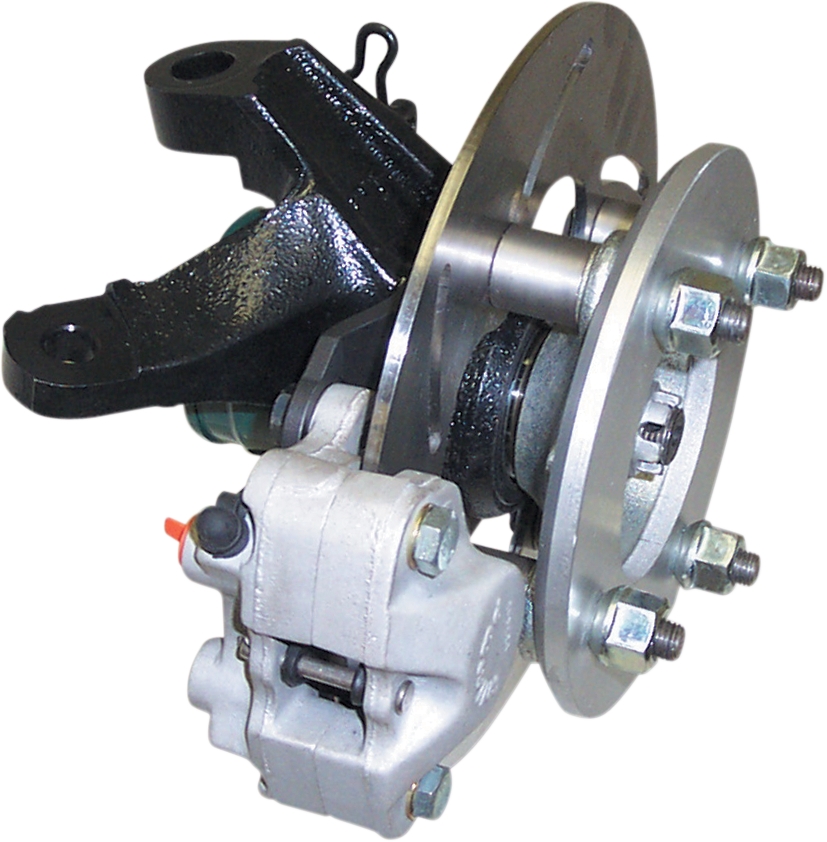
Bikes set up this way, with a caliper just on one of the rear wheels, will likely have a locked rear diff, effectively making both wheels brake when you step on the pedal.
It would be best if you learned how your specific bike’s brakes work because mistakingly believing you will get full brake power only from using your foot pedal can be a fatal mistake.
If you suddenly need to stop at fast as possible, activating just the rear wheel brakes will on these bikes give a much longer stopping distance than when all wheels are braking.
To learn how your bike is designed, you can inspect where the foot pedal master cylinder’s brake lines go.
Or, you can test the bike at slower speeds on an open gravel lot, with no risk of smashing into others.
If the rear end starts sliding to either side when you use the foot pedal but not when you’re using the hand lever, you know that the foot pedal likely only activates the rear brakes.
ATVs that do not have disc brakes will likely have drum brakes. Drum brakes are more common on cheaper or older models. You may also run into models with drum brakes on the rear wheels but disc brakes on the front.
Drum brakes are more common on cheaper or older models. You may also run into models with drum brakes on the rear wheels but disc brakes on the front.
Drum brake systems are fairly simple designs, but they are generally not as effective as disc brakes.
These are the components they are made up of and how they work together:
Operates the same way as on disc brake systems.
Connected to the hand lever or foot pedal, you’ll find a brake cable. The cable consists of a thin steel wire inside a protective housing where it can slide freely back and forth as you operate the brake lever.
The brake hub is fitted where the suspension meets the wheel and spins freely at the same speed which the wheel turns. The drum is all metal, and inside, it is shaped like the inside of a drum, hence the name, drum brakes. The inside steel walls of the hub serve the same purpose as the discs on the disc brakes.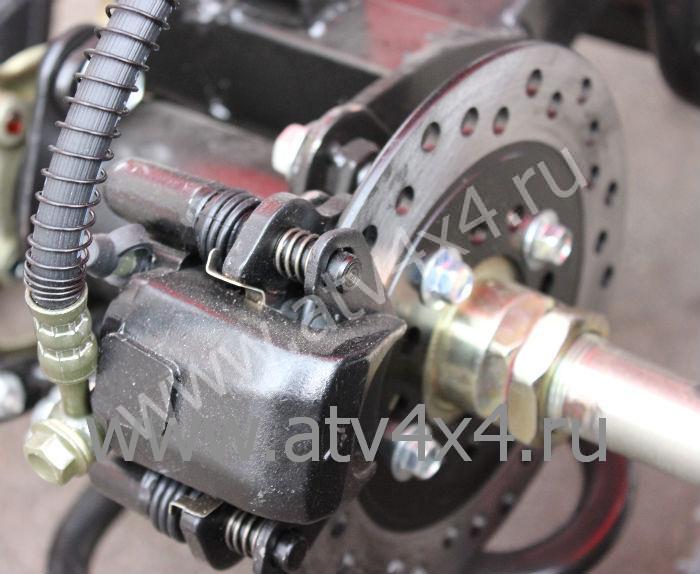 They create friction when brake pads are pushed against them.
They create friction when brake pads are pushed against them.
Inside the brake drum, you’ll find the brake shoe, which works similar to how brake pads work on disc brakes. Two brake shoes in each hub are the most common setup.
The brake cable is connected to a lever on the brake hub, that when pulled, forces the brake shoes outward against the steel drum, creating the braking effect.
Small springs connected directly to the shoes then retract them away from the drum when you release the brake lever or foot pedal.
Most bikes are fitted with a parking brake system to help keep the bike in a stationary position whenever parked.
I always use it when parking in steep hills to help the bike’s transmission slip more easily in and out of PARK.
While on many cars, you usually have a separate brake wire that bypasses the hydraulic braking system, this is not the case on ATVs.
Usually, the parking brake works by locking the hand lever in the activated position. This utilizes the bike’s primary braking system as a parking brake. It will keep the brakes on all four wheels constantly activated until the brake is released.
This utilizes the bike’s primary braking system as a parking brake. It will keep the brakes on all four wheels constantly activated until the brake is released.
The locking mechanism will look a bit different from model to model but works by the same principles. On my Polaris, you find a two-step switch where you can choose how much force you wish to apply.
Parking brake locking mechanism on a Polaris Sportsman XP 1000You may find a more simple hand brake locking mechanism like the one I have on my old Lynx snowmobile on older bikes.
Parking brake locking mechanism on a Lynx 5900 GLX. Also, notice the steel wire cable in this non-hydraulic system.
As Can-Am recently introduced ABS braking systems to the ATV world, I’ll end this post with a few lines on the basics of how this system works.
An ABS system basically consists of the same components as a conventional hydraulic brake system with some additional anti-locking components.
The additional components are a hydraulic electronic control unit (called ECU) plus a few hydraulic pressure sensors and speed sensors.
The sensors detect how the wheels behave in different braking situations and send it’s signal to the ECU.
The ECU is the brains of the operation, and based on the sensors’ signals, it calculates and adjusts how much braking force that needs to go to each caliper for optimal stopping power.
This all happens instantly and much faster and more precise than any rider could achieve on non-ABS systems.
What to do when ATV brake pads are squealing?
ATV brakes squealing may be because of dirt on the brake pads and discs. Try cleaning them with brake cleaner. Installing an anti-squeal sticker made from aluminum will also work.
Try cleaning them with brake cleaner. Installing an anti-squeal sticker made from aluminum will also work.
Keeping your brakes in good condition is critical for ATV maintenance. Once your brakes start to wear out, you could be putting yourself into dangerous situations. You need to be able to stop quickly and successfully at all times on an ATV.
Mud and moisture is the main killer of ATV brake pads, as well as excessive use. Brake pads do their job best under dry conditions. I’m not saying avoid mud, that’s the best part of off-roading, but it’s just something to be aware of.
To complete a successful brake pad swap out, the first thing you need to be aware of is if you have disk brakes or drum brakes.
Most newer quads you will see with disk brakes for every tire. Hydraulic disk brakes are the norm now a days, but you still see drum brakes here and there, and more on older four wheelers. The hydraulic disk brakes are so popular because they stop so much more effectively, limiting the amount of ATV accidents and injuries.
You will be able to easily tell if your brakes are disk or drum brakes by looking for the brake system behind the tire or on the axle. Here are some examples:
ATV Disk BrakesYou will notice where the ATV disk brakes got their name, there’s an actual disk that the brake pads press against to slow the machine down.
These are very common for sport or racing quads. The front disk brakes will very similar except they will most likely be behind the front tire, usually on both sides of the front wheels.
This is because the front brakes are used more often and are so much more critical to slowing the machine down quickly.
ATV Drum BrakesThe drum brakes will look like this picture, they are enclosed with the brake shoes being pressed onto the the wall of the drum inside the drum itself.
These are more often found on older quads or on utility ATVs on the rear wheels. Since the front brakes are most important, it’s usually fine for the the back brakes to be the less effective drum style brake system.
After you figure out which brake system you have, drum or disk, you can get the parts and do a brake pad change.
If you do have drum brakes but want disk brakes, they sell pretty good Disk Brake Conversion Kits on Amazon, just make sure to get the right kit for your make and model.
But what type of pads will you want to get? Let’s talk about the different brake pad materials.
There are three common types of brake pad material to choose from. Ceramic, Metallic, and Organic. Ceramic are usually the most expensive but run a lot cleaner. They create less brake dust which in turn causes less wear and tear to your other brake system components.
Metallic brake pads are popular for sport quads because of the high temperatures they can withstand. But they tend to be noisy and rough on the rotors. Semi-Metallic brake pads are optimal for an everyday rider.
Organic brake pads are the cheapest option of the three.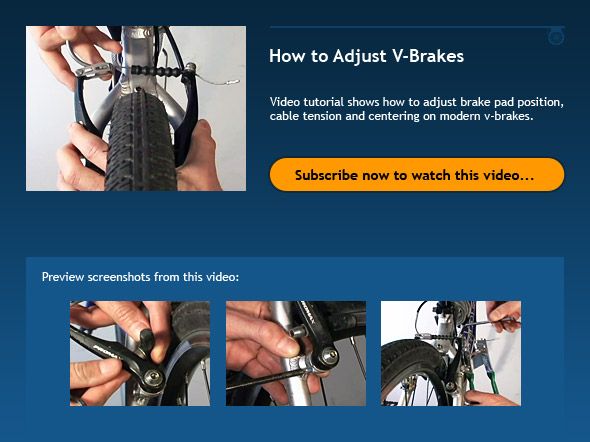 They are easy on the rotors, and contain no metallic material. The down side is they offer the least performance and slowest braking time.
They are easy on the rotors, and contain no metallic material. The down side is they offer the least performance and slowest braking time.
Semi-Metallic brake pads are the most common and best for everyday use. Here is a link to Semi-Metallic ATV Brake Pads on Amazon to help get your search started. Make sure you get the right set for your make and model.
First step is to make sure you have all the tools you need to complete the job. Unless you like running out to the parts store in the middle of a job. Most of these tools are very common and already in most garages.

Once you have all your tools and parts ready, it’s time to replace the brake pads. This is a pretty easy straight forward process.
First remove the ATV tire and wheel assembly from the machine. It’s best practice to loosen the lugs while the ATV is on the ground. Then lift the quad and remove the lugs and wheel.
This is usually done with a socket set, sometimes with an allen wrench. Look on the back of the caliper and you will notice two bolts that hold the brake assembly on.
Remove these bolts and the whole assembly comes off the rotor. The pads may still be on the caliper held there by two pins.
You will need to suppress the pins on the caliper to remove the brake pads. This is where you’ll use the vice grips or clamp. Once suppressed the brake pads will easily fall right out of the caliper housing.
This part can be a bit of a pain, but if you get the vice grips on just right you won’t have any problems.
You will need to compress the caliper piston with a c clamp or something to get the new brake pads in the caliper.
Once you compress the caliper piston you can remove the clamp and insert the new brake pads.
Remember to set the pads back on the caliper pins just the way the old ones were installed. You will need the vice grips again to compress the pins to put the new pads on.
Simply put the brake assembly back onto the machine by bolting the caliper back into place. There you have it, you just changed your brake pads. Not that difficult of a job, and can be easily done in less than an hour once you know what you’re doing.
There you have it, you just changed your brake pads. Not that difficult of a job, and can be easily done in less than an hour once you know what you’re doing.
Put the wheel and tire back onto the machine and lower the jack. It’s best to loosely put the lugs on while the machine is jacked up, and then firmly tighten the lugs after you’ve lower the quad back to the ground.
Press the brake down to be sure that your brake is working properly. The first or first two pumps on the pedal are soft as the piston started at a new point on the backside the brake pad.
This might be a good time to check your brake fluid and replace or add any if needed. If you want to bleed the brakes and get all new fluid in there check out this article on How To Bleed Your Brake Fluid On An ATV.
The average rider can go a few years before needing new brake pads. It’s not a good idea to judge if you need pads by how long it’s been since last replacement though. Since everyone rides their machine differently and with differing frequency, there are better ways to check of you need to do a replacement.
Since everyone rides their machine differently and with differing frequency, there are better ways to check of you need to do a replacement.
The best way to tell if you need to replace your ATV brake pads is by looking at the thickness of the pads. You could always measure them by hand, but a quick look is enough to tell if they’re worn out.
In this picture the pads on the right are worn and the pads on the left are new.
Another way to tell is if you hear a scraping noise while using your brakes when you’re riding. If you press down hard on the brakes and notice a jittery feeling in your handle bars, that’s another sign you should check out your brake pads.
Sharing is caring!
We all are well aware of the principle of operation of the drum brake system, it is based on the expansion of the pads, and the mechanism is driven by a brake cable. Disc brakes work differently. The brake mechanism actuates the brake fluid, which is developed according to a special technology and does not respond to temperature changes. Serviceable disc brakes are many times more reliable than drum brakes, that's a fact. nine0003
Disc brakes work differently. The brake mechanism actuates the brake fluid, which is developed according to a special technology and does not respond to temperature changes. Serviceable disc brakes are many times more reliable than drum brakes, that's a fact. nine0003
Most ATV models are equipped with a mixed brake system. For example, disc brakes are installed on the front wheels, and drum brakes on the rear wheels. But it is also not uncommon for both circuits to be either drum or disc.
It should be said that under the condition of hard use of the ATV (jumping, increased shaking, unstable position of the wheels), it is necessary to use a disc (hydraulic) brake system, since when using drum brakes, sometimes one hand effort is not enough. Whereas when using disc brakes, you will only need a slight effort of your hand to apply and brake unhindered. nine0003
So, let's look at the mechanism of the disc brake system.
Brake fluid is filled into a dedicated brake expansion tank (located on the handlebars or attached to the ATV frame).
What happens when you press the handle or the brake pedal?
Manual brake control.
Foot brake control.
The handle or pedal presses on a piston, which in turn drives the brake fluid in the hoses, creating pressure that is transferred to the brake caliper, which has its own piston. nine0003
Rear brake caliper.
Front brake caliper.
Under pressure, the brake caliper piston moves the pads, which compress the brake disc.
Brake shoes.
When braking, there is a lot of pressure on the pads that can stop the ATV.
Of course, under such loads, you should pay attention to the lining of the brake pads. High-quality braking is possible only with the use of serviceable brake pads, which are regularly serviced. You can read about how to make your own brake pads here. nine0003
The brake disc is made of durable steel.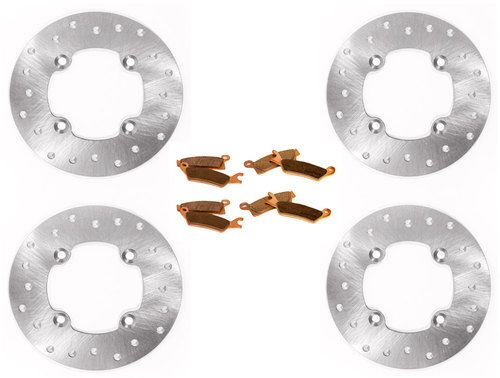 Along the perimeter, the disk has holes for ventilation and self-cleaning from dirt.
Along the perimeter, the disk has holes for ventilation and self-cleaning from dirt.
Remember to be safe, regularly inspecting your ATV's braking system is essential for the health of you and your passenger. When inspecting, special attention should be paid to the brake hoses, the condition of the pads, the level of brake fluid in the reservoir, and the condition of the brake disc.
We recommend DOT 3 brake fluid.
"Cleaning and replacement of ...
... "
Buying a reliable ATV is great. But in order for it to be really reliable and not fail at the most inopportune moment, it must be regularly serviced, and in particular, the brakes must be bled after the repair of the elements of the brake system.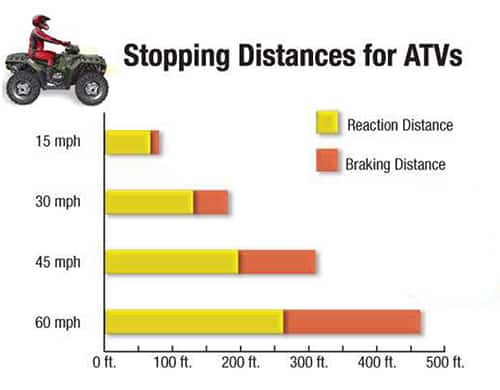
To bleed the ATV brakes yourself, you will need the following tools:
ATV's brake circuits operate from the front and rear brakes. The first is located on the frame of the vehicle, and the second is on the steering wheel.
To complete this procedure, and Linghai ATVs are no exception, you need the help of a friend. Bleeding the rear and front brakes of the ATV is as follows:
 These actions must be continued until all the old brake fluid has poured out of the barrel and a new one has come out;
These actions must be continued until all the old brake fluid has poured out of the barrel and a new one has come out; Checking if the ATV's brakes have been bled properly is quite simple, just press them. If you feel a moderate hardness, then everything went well, and if they are still soft, then this means that air has entered the brake system. To get rid of it, slightly loosen the brake hose fasteners.
Among the most common breakdowns of the ATV brake system, it is worth highlighting:
If your ATV's disc brakes are deteriorating, it is recommended that you bleed them by changing the brake fluid.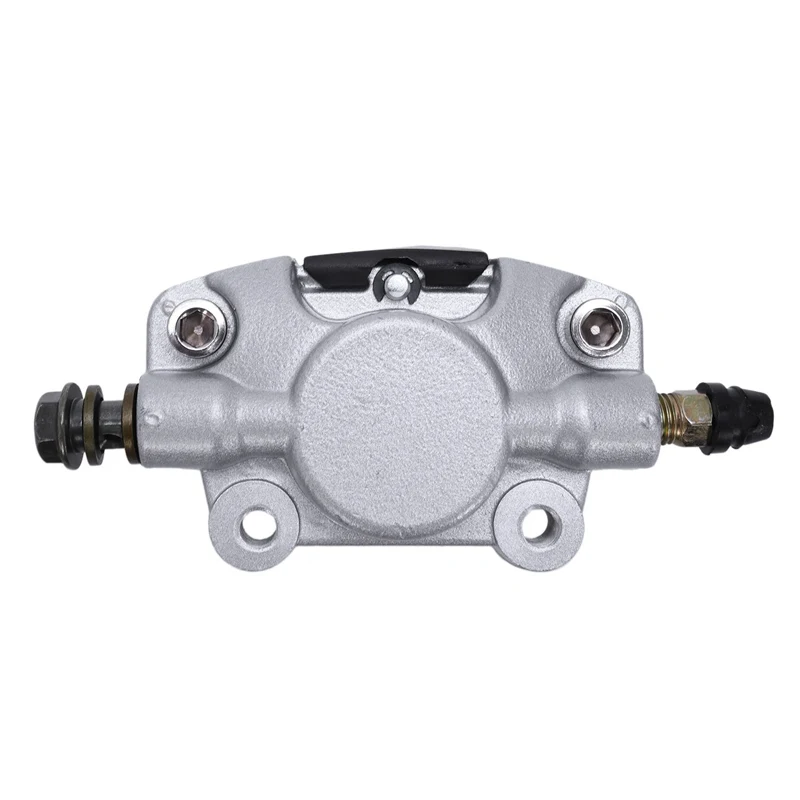 Preliminary check all elements of the brake system for serviceability and absence of damage in order to exclude the possibility of their wear. If any part of the ATV is still out of order, then it should be replaced with a new one. nine0003
Preliminary check all elements of the brake system for serviceability and absence of damage in order to exclude the possibility of their wear. If any part of the ATV is still out of order, then it should be replaced with a new one. nine0003
Brake pads break more often than other functional motorcycle components because they are made of composite materials instead of metal. The pads can be replaced both independently and by contacting a service center. Quite often, the brake calipers of the ATV also break. With sudden braking, they overheat, which negatively affects the service life of this component. In order not to have to repair the brake calipers too often, it is recommended to change the oil regularly. Sometimes calipers from OKI are put on ATVs, but before that they need to be somewhat modified on a milling machine. A good option if the original calipers cannot be repaired. nine0003
Bleeding the brakes on children's ATVs is the same as on full size motorcycles. The main thing is to choose a high-quality and reliable brake fluid that will cope with its task at a decent level.
The main thing is to choose a high-quality and reliable brake fluid that will cope with its task at a decent level.
The most wear and tear-prone component of a child's ATV is the brake pads. Fortunately, you can determine this malfunction by eye. If the pads look frayed and worn, then it's time to change them. Among other signs it is worth highlighting:
Although children's motorcycle brakes are not subjected to excessive stress, they should be checked for stability and performance at least twice a season.
Diagnostics and timely repair of the brake system of an ATV should always be given special attention, since the safety of the rider largely depends on its operation. Regular maintenance of the rear and front brakes of the vehicle can be done both on its own and by contacting the services of service center specialists for help.